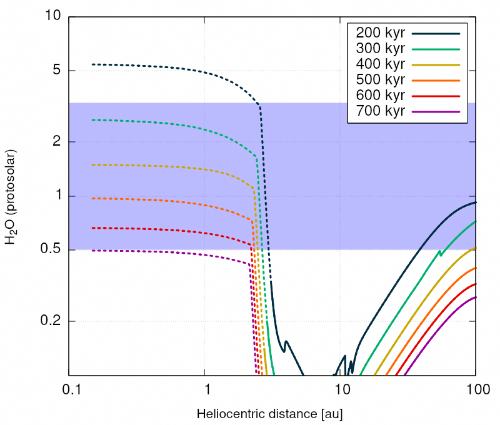- 1Aix Marseille Univ, Institut Origines, CNRS, CNES, LAM, Marseille, France (artem.aguichine@lam.fr)
- 2Aix Marseille Univ, Institut Origines, CNRS, CNES, LAM, Marseille, France
- 3Department of Astronomy, Cornell University, Ithaca, NY 14853, USA
Two decades ago, the Galileo probe performed an in situ measurement of elemental abundances in Jupiter’s atmosphere, which resulted in a number of formation scenarios to explain observations [1-4]. These measurements indicated that volatile abundances of C, N, S, P, Ar, Kr and Xe were enhanced by a factor of 2 to 6 times their protosolar value, except for O that was found to be subsolar. The more recent measurements made by Juno confirmed the supersolar abundance of N, but found that a supersolar abundance of O is possible [5]. This result calls for an update of existing models and formation theories. Here, we investigate the possibility of reproducing the composition of Jupiter’s envelope in the protosolar nebula (PSN).
To do so, we compute the evolution of the PSN using a 1D viscous accretion disk model [6,7]. The disk is initially uniformly filled with trace species with protosolar abundances, present in the form of dust and ice grains, and their vapor. The radial transport of trace species is computed by solving an advection-diffusion equation, and phase transitions are accounted for by computing sublimation and condensation rates for each species. We then compare the composition of the PSN computed by our model with the updated measurements of elemental abundance in Jupiter.
The figure below represents profiles of the H2O abundance in the disk, normalized to its initial value, at different times of the disk evolution. Solid and dashed lines are used to indicate locations where the disk is dominated by solids (solid lines) or vapor (dashed lines). The blue box corresponds to the measurement of H2O to protosolar O abundance measured in Jupiter’s atmosphere by Juno [5]. Every trace species evolves in a similar fashion, but their icelines are at different heliocentric distances.

We find that the composition of Jupiter’s envelope can be explained only from its accretion from PSN gas or from a mixture of vapors and solids, depending on the turbulence level in the disk. Such compositions can be found at ~4 AU, namely between the icelines of H2O (3.5 AU) and CO2 (5.5 AU), and at times 100–300 kyr of the disk evolution. These results [7] are compatible with both the core accretion model and the gravitational collapse model, but give a new possible scenario of Jupiter’s formation.
[1] Gautier, D., Hersant, F., Mousis, O., et al. 2001, ApJL, 550, L227.
[2] Mousis, O., Ronnet, T., and Lunine, J. I. 2019, ApJ, 875, 9.
[3] Öberg, K. I. and Wordsworth, R. 2019, AJ, 158, 194.
[4] Miguel, Y., Cridland, A., Ormel, C. W., et al. 2020, MNRAS, 491, 1998.
[5] Li, C., Ingersoll, A., Bolton, S., et al. 2020, Nature Astronomy, 4, 609.
[6] Aguichine, A., Mousis, O., Devouard, B., and Ronnet, T. 2020, ApJ, 901, 97.
[7] Aguichine, A., Mousis, O., and Lunine, J. I. 2022, accepted in PSJ.
How to cite: Aguichine, A., Mousis, O., and Lunine, J.: Reproducing the composition of Jupiter’s envelope from the gas phase of the protosolar nebula, Europlanet Science Congress 2022, Granada, Spain, 18–23 Sep 2022, EPSC2022-891, https://doi.org/10.5194/epsc2022-891, 2022.

